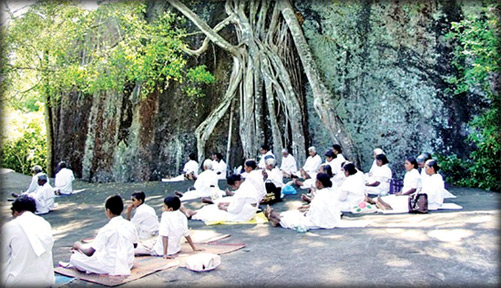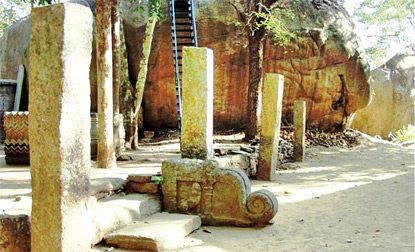Mawaragala forest hermitage - where silence and serenity prevail
By Mahil Wijesinghe
|

Bawanagala a magnificent creation of nature which is used
for observing sil by devotees |
As we drove along the A-26 Mahiyangana-Padiyathalawa road one sunny
morning, I was suddenly struck with the idea of visiting the ancient
forest hermitage called Mawaragala, which lies on the slope of a rocky
mountain in Dambana. There I was at Mawaragala forest hermitage 15
kilometres away from Mahiyangana town, taking the turn just before the
ancestral Adhivasi village, Kotabakiniya.
Neatly kept pathways led us on a steady climb through the forest and
rock boulder, the greenery all around providing a salubrious climate. It
was a hot sunny morning, yet the ample tree shade protected us from the
heat. The rocky landscape and the serene undisturbed environment seemed
ideal for meditation. Those pathways were leading to Kutis or monk’s
adobes built in drip-ledge caves, where monks stay and meditate. The
Mawaragala forest hermitage was on top of a rocky mountain in the midst
of a 500-acre forest. The drip-ledge caves with Brahmi inscriptions were
built on the slope of that mountain. The chief bhikkhu of the hermitage
has taken steps to protect the existing flora, while growing more trees
in the area surrounding the hermitage as well.
At the hermitage, we met a young Samanera bhikkhu named Ven. Kewle
Samithawansa. He took us to every nook and corner of the hermitage while
relating the history of the hermitage to us. At first he took us to the
chief monk’s Kuti. The chief bhikkhu was away from the hermitage at the
time we went there. The history of the hermitage dates back to the King
Valagambahu’s reign. According to legend, an erudite bhikkhu called
Maliyadeva Thera and 60 bhikkhus lived in this spot during that period.
Later, those rock caves had been used by the Adhivasis of Dambana for
dwelling.
“Water is the burning problem for us here. A devotee from Colombo had
donated four water tanks for the use of the bhikkhus and devotees who
come to give alms” said the bhikkhu showing us huge water tanks at the
hermitage.
|

Bhikkhus in the Mawaragala hermitage walking Pindapatha for
midday meal |
“Today what we need is a spacious resting hall for devotees who come
from far away places to give alms. We don’t even print books to sell to
people to collect money for the building. Whatever they give, we accept.
Most of the people in our village are Adhivasis. They don’t have a
proper income to make ends meet. We can’t expect anything from them.
Most of our Dayakayas (devotees) are outsiders,” he said. All in all,
there are enough Kutis for at least 25 bhikkhus at the hermitage.
These
have been built inside the drip-ledge caves in the forest reserve, away
from the entrance to the hermitage where the shrine room is located. A
small building is built for devotees to prepare alms for the bhikkhu. It
is only during restricted periods that visitors are allowed into the
area where the Kutis are located. The restricted time is between 11.30
a.m. and 1 p.m. This is to avoid disturbing the meditating bhikkhus.
During our stay at the hermitage, we witnessed the midday meal (alms
giving) activities. Over 20 bhikkhus were present for the midday dana.
At around 11 am one monk rang the bell to alert the monks in distance
Kutis, informing them to gather near the main entrance. From there, they
walked to the Danasalawa (alms hall). It was a rare sight, to see them
walking silently down the pathway on Pindapatha, in keeping with the
tradition dating back to the days of the Buddha.
They came in single
file, one after the other, each carrying an alms bowl. Once their feet
were washed, they moved as one, and patiently let the devotees serve the
alms which they prepared in the morning, into their begging bowls. Then
they retired into the alms hall located a little further in the forest
and sat down to eat the food they had been offered.
|

Samanera Bhikkhu in front of his Kuti |
|

Ruins of an ancient structure of the hermitage |
The Bawanagala was the most interesting place to see in the
hermitage. The rock surface offered naturally laid floor area, which was
about 25 square feet. Legend has it that it was where monk Maliyadeva
and 60 monks meditated. The holes on the rock surface, it was learnt
were indications that in the past it was covered with a roof to offer
shelter to the monks from the rain and sun.While there are meditating
monks in permanent residence at the hermitage, foreign bhikkhus also
visit and stay for a short period to practise meditation. In addition to
meditation, the hermitage has a Pirivena (school for novice monks) for
those who come from places such as Padiyathalawa, Maha Oya and other
remote areas.
The award-winning film, Suriya Arana that was filmed in a cave of
this hermitage, is a favourite site among visitors who come to see this
place. Ven. Samithawansa who was our guide at the hermitage took us to
the cave through a footpath to show us where the filming was done. The
Mawaragala forest hermitage is a gift of nature where silence and
serenity prevail-the ideal place for meditating monks who struggle to
seek emancipation, and finally attain nirvana. The place is open for
nature lovers- the best medicine for a stressed-out mind. Before we left
the hermitage, I told Ven. Samithawansa- “the forest of the hermitage
has been protected because the people in the village love the forest”.
Although they are poor, the Adhivasi community of Dambana is
instrumental in this task.
Pictures: Mahil Wijesinghe
|

